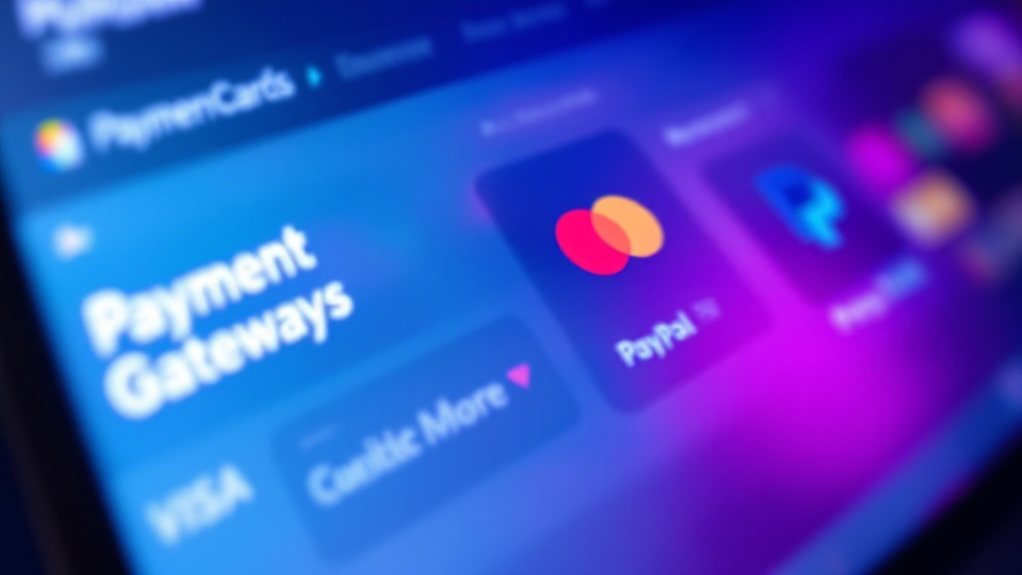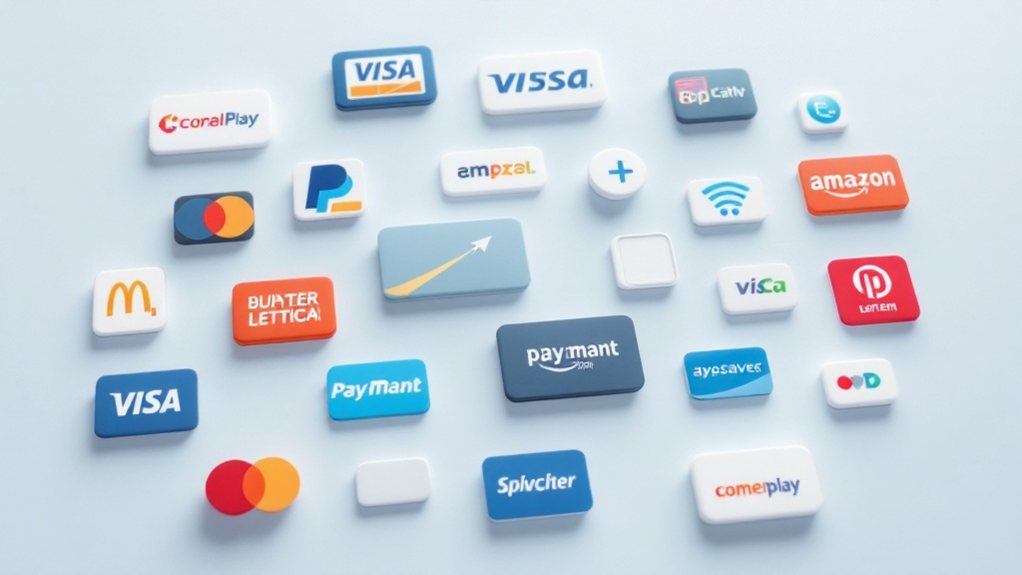When integrating a payment gateway with your e-commerce platform, consider the pricing structure, evaluate integration options, prioritize security, assess the customer experience, and ensure global reach. Confirm platform compatibility, implement robust encryption, streamline the checkout process, offer multiple payment methods, and maintain PCI compliance. Monitor transactions and leverage analytics to optimize your payment integration – there's more to explore.
Key Takeaways
- Evaluate payment gateway compatibility with the e-commerce platform's features, security protocols, and integration capabilities to ensure a seamless implementation.
- Prioritize payment gateway security by implementing robust encryption, adhering to industry standards, and regularly monitoring for vulnerabilities.
- Optimize the checkout experience by streamlining the process, offering multiple payment options, and ensuring a mobile-friendly layout to enhance customer satisfaction.
- Maintain PCI compliance by regularly reviewing the platform's security measures, training staff, and choosing PCI-certified payment gateways.
- Assess the pricing structure and global reach of the payment gateway to align with the e-commerce business's requirements and target markets.
Choose the Right Payment Gateway

When selecting a payment gateway, you'll want to weigh several key factors. First, consider the pricing structure – some charge transaction fees while others have monthly or yearly fees. Evaluate the available integration options to ensure a seamless connection with your e-commerce platform. Security is paramount, so look for gateways with robust encryption and fraud protection. Evaluate the customer experience, as a simple, user-friendly checkout process is crucial for conversions. Finally, assess the gateway's global reach and support for multiple currencies if you have international customers. Choosing the right payment solution can significantly impact your online business's success, so do your research to find the best fit.
Assess Your E-Commerce Platform's Compatibility
Once you've narrowed down your payment gateway options, the next step is to ensure your e-commerce platform is compatible with your chosen solution. Assess whether your platform supports the gateway's integration features, payment methods, and security protocols. Check if any customization or development work is required. Consider the ease of implementation and ongoing maintenance. Compatibility is crucial to delivering a seamless checkout experience for your customers. Confirm your e-commerce platform and payment gateway can communicate effectively, allowing for secure, reliable transactions. This evaluation will help you make an informed decision and avoid potential integration challenges down the line.
Secure Your Payment Integration

Securing your payment integration is paramount, as it safeguards your customers' sensitive financial information. Implement robust encryption protocols, like SSL/TLS, to protect data in transit. Adhere to industry security standards, such as PCI DSS, to demonstrate your commitment to data protection. Regularly audit your system for vulnerabilities and promptly address any issues. Employ strong access controls, limiting staff access to payment data. Monitor transactions for suspicious activity and have a plan to respond to security breaches. Partnering with a reputable payment gateway can also bolster your security, as they manage the complexities of PCI compliance. Securing your payment integration is an ongoing process, but it's essential for building customer trust and protecting your business.
Optimize the Checkout Experience
Optimizing the checkout experience can boost your e-commerce platform's conversion rates and customer satisfaction. Streamline the process by minimizing the number of steps and required fields. Offer guest checkout to reduce friction for first-time buyers. Provide clear and concise instructions, and use autofill to pre-populate information. Implement a mobile-friendly layout with large buttons and easy navigation. Allow multiple payment options, including digital wallets and buy-now-pay-later services. Showcase security badges and trust signals to instill confidence. Monitor and analyze checkout data to identify and address pain points. Continuously iterate and optimize the experience based on user feedback and behavior. A seamless, user-centric checkout can turn browsers into buyers and drive long-term loyalty.
Offer Multiple Payment Options

Providing your customers with a diverse range of payment options can significantly enhance their checkout experience. Offering choices like credit/debit cards, digital wallets, and alternative payment methods like buy-now-pay-later caters to different consumer preferences and financial needs. This flexibility boosts customer satisfaction and conversion rates. Integrate popular gateways like PayPal, Stripe, and Apple Pay to give buyers the options they expect. Optimize the display and organization of payment choices to ensure a smooth, intuitive flow. Regularly review your offering and add new methods as they gain traction. Catering to evolving payment trends keeps your e-commerce platform competitive and customer-centric.
Ensure PCI Compliance
As you integrate various payment gateways, it's crucial to ensure your e-commerce platform is PCI compliant. The Payment Card Industry Data Security Standard (PCI DSS) sets strict guidelines for securely handling credit card data. Failing to comply can result in hefty fines and reputational damage. Regularly review your platform's PCI compliance, update security measures, and train staff on best practices. Choose payment gateways that are PCI-certified and provide robust security features. Encrypt sensitive data, implement access controls, and conduct periodic vulnerability assessments. By prioritizing PCI compliance, you'll protect your business and customers from the risks of data breaches and fraud.
Monitor and Manage Transactions

Effective transaction monitoring and management are crucial to the success of your e-commerce platform. Regularly review your transaction data to identify any suspicious activity or potential fraud. Leverage your payment gateway's reporting tools to track sales, refunds, and chargebacks. Automate alerts for anomalies, enabling you to respond quickly. Implement robust fraud detection measures, like IP geolocation and velocity checks, to mitigate risks. Streamline your dispute resolution process, ensuring timely responses to customer inquiries. Continuously optimize your transaction management strategies to enhance the customer experience and minimize financial losses.
Leverage Analytics for Optimization
Leveraging data analytics can unlock valuable insights to optimize your e-commerce platform's performance. By analyzing transaction data, you can identify high-performing products, understand customer behavior, and refine your pricing strategies. Leverage real-time monitoring to detect anomalies and address issues promptly. Segment your customer base to personalize the shopping experience and boost conversion rates. Utilize A/B testing to experiment with different layouts, content, and features, then use the data to make informed decisions. Integrate your payment gateway with your analytics platform to gain a holistic view of your business. With these insights, you can continually enhance your e-commerce operations and stay ahead of the competition.
Stay Updated on Payment Trends

Staying up-to-date with the latest payment trends is crucial for the success of your e-commerce platform. Regularly monitor industry news and reports to understand evolving customer preferences, emerging technologies, and regulatory changes. Explore new payment methods like mobile wallets, buy-now-pay-later options, and cryptocurrency acceptance. Analyze your customer data to identify popular payment options and optimize your checkout process accordingly. Partner with a flexible payment gateway that can accommodate these trends and provide seamless integration with your e-commerce platform. Continuously evaluate and update your payment strategy to enhance the customer experience and stay ahead of the competition.

